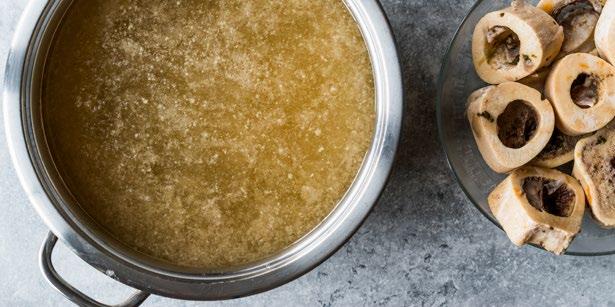
6 minute read
The Dangers of Complex & Simple Carbs 110 Nourish Your Mind & Feed Your Soul
Mix it with other Meats
Liver usually comes in whole pieces, but you might consider asking your butcher about ground liver — it’s much easier to work with and incorporate into other dishes. Once you’ve got a package of ground liver, you can mix it 20/80 with regular ground beef. Chances are you won’t even notice the liver. If anything, the mixture will taste slightly sweeter than your normal ground beef. It can be made into hamburgers, cheeseburgers, meatballs, and meatloaf.
Bathe it in Tallow or Butter
When in doubt, there’s a classic way to enjoy beef liver: fry it in liberal amounts of salt and butter. This approach is both simple and effective. First, place a pan over high heat, then melt some butter or tallow in the pan. Once the cooking fat is nice and hot, add some thin strips of liver. Finish by adding some salt and bacon for extra crunch and flavor.
Eat it Raw
Yep, you read that right. Beef liver can indeed be enjoyed raw. Dr. Kiltz likes to get the liver, slice it down, and freeze it flat. Then he takes out a small piece at a time, cuts it into swallowable, bite-size pieces, salts it, lets it defrost a few minutes. Then he takes a tiny chew with water and down it goes.
Many raw liver fans find that it has a sweet flavor and pleasant mouthfeel, though some of the more nuanced aspects of liver’s taste are lost during cooking. Just be aware that raw liver is pretty chewy, so be sure to slice it into thin pieces or small cubes before enjoying it.
The age of the liver you’re preparing also contributes to its flavor. Veal liver has a milder taste, while mature animal liver may taste stronger and earthier.
Other ideas for preparing liver
• Pan-fry liver, onions, and mushrooms with some butter
• Chop some liver, then mix with regular ground beef into meatballs and serve with tomato sauce
• Use calf or lamb liver instead of mature beef liver for a milder taste
• Soak your liver in milk or lemon before cooking to reduce its flavor
Remember that quality matters when it comes to beef liver’s benefits. Source your liver from New Zealand if you don’t have access to organic cattle farms you can trust. And, regardless of what you do with liver, be sure to enjoy your journey towards better health!

Carnivore Snacks
Interested in getting started with the carnivore diet, but worried about the cost of all that meat? You’ll be happy to learn that it’s possible to go carnivore without breaking the bank. Here are some tips and strategies for eating carnivore on a budget.
Top Whole Food Carnivore Snacks
Steak Leftovers Eggs Cheese Butter Pork Rinds Freeze Dried Beef Organs Beef Jerky & Biltong Kiltz Ice Cream Bone Broth

Bone Broth: Why You
Should Be Drinking It Too
Have you seen the term “bone broth” popping up on carnivore blogs and recipes? You may have seen it on the shelves of your local grocery store or Trader Joe’s and wondered what it was. So, what is it and why should you be jumping on the bandwagon?
Bone broth is exactly what its name implies. It’s a broth made from cooking down animal bones and other connective tissue (feet, beaks, spines, gizzard, legs, hooves, hocks, or even the whole carcass) with water and adding an acid like vinegar or lemon juice to help break down the collagen. It can be made from chicken, turkey, lamb, pig, beef, fish, and other wild game. Many people roast the bones first for a richer, deeper flavored broth.
Bones contain lots of nutrients which provide some pretty impressive health benefits. It’s high in various minerals, collagen, glycine, glucosamine and chondroitin. BONE: The bone itself yields minerals like calcium and phosphorus. Sodium, magnesium, potassium, sulfur and silicon are also present.
MARROW: Bone marrow gives you vitamin A, vitamin K2, omega-3s, omega-6s and minerals like iron, zinc, selenium, boron and manganese. Marrow from beef and lamb also contains CLA.
CONNECTIVE TISSUE: This tissue provides glucosamine and chondroitin, which are popular dietary supplements for arthritis and joint pain.
While it can be used as an ingredient in soups and sauces, many people drink a cup as part of their regular daily routine. It’s a great snack and a soothing way to start or end the day. Adding a bit of extra sea salt to your bone broth and drinking it in the early stages of transitioning to carnivore can help ward off the keto flu. When you stop eating so many processed foods, you take in a lot less sodium, some of which your body needs. This is one way to add it back. • Anti-inflammatory: The glycine may have some anti-inflammatory and antioxidant effects.
• Weight Loss: It’s low in calories and sugar-free, but still helps you feel full. This may be due to its gelatin content, which can promote satiety.
• Joint Health: Glucosamine and chondroitin improve joint health and reduce symptoms of osteoarthritis.
• Bone Health: Calcium, magnesium and phosphorus all promote good bone health.
• Sleep and Brain Function: Glycine taken
before bed has been shown to improve sleep and brain function. Whether you buy it or make it, the health and flavor of the bone broth is ultimately dependent on the quality of the ingredients: where did the bones come from? What did the animals eat? How long was it cooked? If you don’t have the time to make it yourself, be sure to read the ingredients of various bone broths before you settle on one to try. Kettle & Fire makes a good one, but there are other quality bone broths out there.
If you make it right, you’ll see bits of “jelly” in your broth. Bones, marrow and connective tissue are all largely made up of collagen, which turns into gelatin when cooked.
Simple Bone Broth Recipe
INGREDIENTS
• 2–3 pounds of beef bones.
• 4 liters (1 gallon) of water.
• 2 tablespoons apple cider vinegar.
• 1 onion (optional).
• 4 garlic cloves (optional).
• 1 teaspoon of salt and/or pepper (optional).
DIRECTIONS
Put bones and vegetables in a big, stainless steel pot*.
Pour cold water into the pot so it covers the contents. Add the vinegar, and then raise the temperature to bring to a boil.
Reduce heat, add salt and pepper, and then let simmer for 4–24 hours (the longer it simmers, the tastier and more nutrient-dense it will be). Allow the broth to cool, and then strain the solids out.
Now it’s ready.
You can also add other meat, veggies or spices to your broth. Popular additions include parsley, bay leaves, carrots, celery, ginger, lemon rinds and liver, but they are not required.
Broth may be stored in an airtight container in the refrigerator for up to 5 days, or in the freezer for up to 3 months.
For those who prefer to multi-task (cook and sleep), you may also want to use a pressure cooker, slow cooker or Crock-Pot. You can use a Crock-Pot to make bone broth overnight.
*For extra flavor, roast the bones before adding to pot. Preheat oven to 450°. Roast bones on a parchment-lined rimmed baking sheet for 30 minutes.






